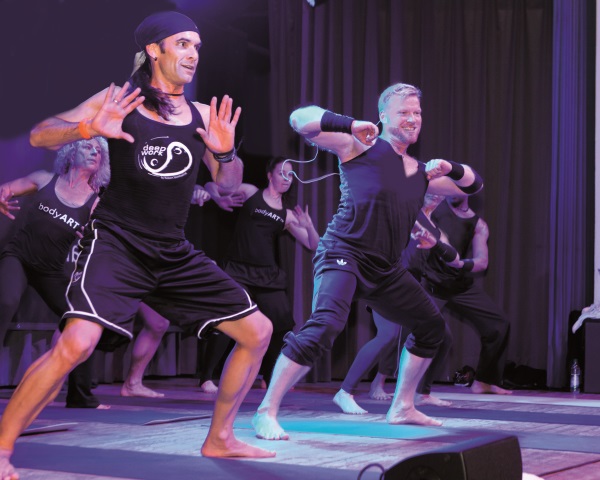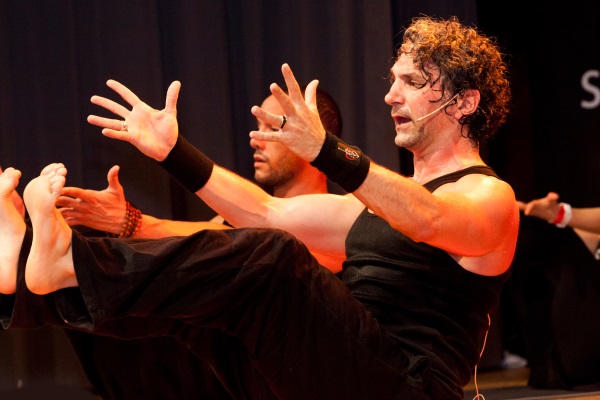myASPRIA’s Nadine Zaydan explains the power of the BodyART training phenomenon.
Robert Steinbacher’s body training method has become a worldwide phenomenon. His method has been exported to the US – usually it is the other way around. It has become a sensation over there, where it is called the “amazing workout from overseas”. Without any marketing on his part, the method practically exported itself. The fact that Madonna is bodyART’s biggest believer is not the only reason this therapeutic method has become so famous. Sought after by celebrities, professional dancers, health seekers and many more, fans fill up parts of Central Park to train by the hundreds. Robert offred more insight into the full depth of the bodyART experience.
Five elements of Chinese medicine
Using an holistic, therapeutic approach, bodyART integrates the five elements, which are linked to different energies. All of our organs belongs to one of these energies. The element ‘Earth’ is linked to rising energy, which translates as the mobilization of the entire spine during the training. ‘Wood’, or the expanding energy, is the warm up and prepares the body internally for hardcore training. ‘Fir’e and its circulating energy is the main training. As it is the energy of circulation you are now training your heart as well, and your entire cardiovascular system. With ‘Metal’, the descending energy, comes stabilization. We are left with ‘Water’, the quiet energy, involving breathing techniques and tai chi.
Robert Steinbacher refers to himself as a movement therapist. “In many sports, you go for the external, the competition. At the moment, in the fitness industry, it’s very much about ‘harder is better’; it’s superficial and hard on the body in the long run. So I wanted to create a training which has a different aspect: you focus on the internal and you get an amazing body as a side effect!”
Therapy training: a body of emotions
The method is based on twenty four years of research on how to strengthen the body and help people on a psychological level as well as a physical one. With it comes the ability to release emotions through the importance of breathing. Steinbacher says: “You’re born with an inhale, you die with an exhale. Through full breathing you can control the entire body and your emotions. Breathing is the key to healing the human body and it is also its navigational system.”
He describes the myofascial tissues as “a sort of net” that surrounds all our bones, muscles and organs, and in which are stored all of our emotions. “Every emotion you have in your life, every traumatic experience stays in your tissue muscle and you can only release it through certain exercises and breathing techniques. Something you can’t achieve with yoga or even a therapist. A great deal of crying has occurred during or after training because of all the emotions that are released.
The “humble” training
BodyART has followers of every kind. For example, the German football team players use it to incorporate more awareness in their training. Injured people are also a massive clientele as they are not able to do ‘hard training’. Steinbacher says: “It is very humble, everybody can do it. It’s humble but painful in a good way. He compares it to a massage session, where the therapist hits the trigger spot: it’s painful yet it feels good. He continues: “It’s the same with bodyART. We find the places that are out of order and we put them back into place. The feeling is so amazing that people come out of the class saying they haven’t felt so good in years.”
 “We do not focus on fun!”
“We do not focus on fun!”
Robert is adamant about not being an entertainer. When asked about what he hopes to bring to clients, he insists on the learning aspect, learning more about ourselves. He explains: “BodyART is a meeting with yourself, on an emotional and physical level.”
‘I’m not here to entertain you’ could be his motto as he feels so strongly about it being much more than fun. “I care about the people in the room. I really want to make a change in the human body. I ask myself what do these people need? More flexibility? Strength? Technique? If I get on a plane, I don’t do it for fun. And people have to sign up with me physically and mentally.”







